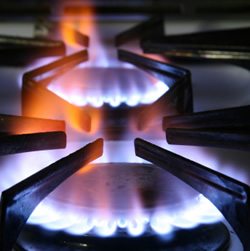
 With increased emphasis on energy efficiency in the building envelope, some builders are also taking a hard look at the fuels used within the home. One approach, called an energy “pod,” focuses on employing a single fuel to power the home’s five key fuel expenditures: space heating, water heating, cooking, fireplaces and clothes drying. By creating a constellation of appliances centered around one fuel source, homeowners can maximize efficiencies in a whole-home energy package.
With increased emphasis on energy efficiency in the building envelope, some builders are also taking a hard look at the fuels used within the home. One approach, called an energy “pod,” focuses on employing a single fuel to power the home’s five key fuel expenditures: space heating, water heating, cooking, fireplaces and clothes drying. By creating a constellation of appliances centered around one fuel source, homeowners can maximize efficiencies in a whole-home energy package.
Both propane and natural gas offer the flexibility of combining across these platforms with a reduced carbon footprint and cleaner emissions. For consumers who are serviced by a natural gas utility, the new reserves of domestic natural gas located in North Dakota and central Pennsylvania offer lower prices and stability when compared to electricity, fuel oil and other energy options. Propane is a petroleum by-product, but seems to fluctuate less dramatically than fuel oil on the retail market.
When compared with electric powered counterparts, propane (or natural gas) water heaters, clothes driers and stoves can provide excellent efficiencies. Tankless water heaters and switch-on propane fireplaces offer on-demand efficiencies for  traditionally energy guzzling appliances. Professional and amateur chefs prefer the instantaneous response of cooking with propane or natural gas. Propane offers an added convenience of on-demand energy with the installation of a propane generator, which can power a home during a electric utility power interruption.
traditionally energy guzzling appliances. Professional and amateur chefs prefer the instantaneous response of cooking with propane or natural gas. Propane offers an added convenience of on-demand energy with the installation of a propane generator, which can power a home during a electric utility power interruption.
 For more information about implementing a gas or propane energy pod configuration in your log home, check out the Propane Education and Research Council’s website.
For more information about implementing a gas or propane energy pod configuration in your log home, check out the Propane Education and Research Council’s website.
